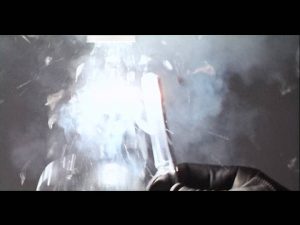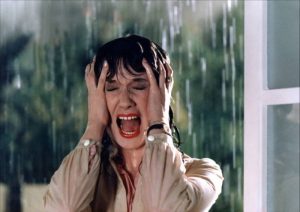Cult Criterion is a series that focuses on cult, horror and exploitation films that are available on DVD and Blu-Ray. Though some well-known titles may be given attention, some that tend to get ignored will also get attention.
In his prime, there was no other director like Dario Argento, who will go down in history as the king of the giallo. Sure, Mario Bava and Lucio Fulci are also noticeable genre directors, and others (such as Sergio Martino, Umberto Lenzi and Massimo Dallamano to name a few) made essential contributions to the giallo world, Argento took what Bava had created and expanded on it. From 1970’s “The Bird with the Crystal Plumage” to 1996’s “The Stendhal Syndrome”, the man was the master of the genre.
However, with 1977’s “Suspiria” and 1980’s “Inferno”, Dario took a stab at the world of supernatural horror. Granted, they still had the giallo standbys (black gloved killers, POV shots and outrageous murder set pieces) but they relied more on the fantastic than they did murder mysteries. While “Suspiria” was mostly met with acclaim, “Inferno” left people divided largely on the fact that it played loosely with logic even by the standards of Italian horror-which is not a genre where “logic” and “coherency” always preside.

Then there was his personal life. At the time, Argento got fucked up fan mail in which people would describe fantasies about killing him in a manner similar to his movies. At the same time, his critics were still not thrilled with his work, and had accused it of everything from misogyny to providing arch conservative messages on sexuality (ironic considering “Deep Red” portrayed a gay character in a non-negative light.) Needless to say, these things began to take a toll on the man, and combined with the mixed reception “Inferno” received, he decided to return to the giallo.
His return was Tenebrae (out now via Synapse Films), which was more than just Dario Argento making a return to the genre he had mastered. Indeed, here he would look at his own legacy and the impact it had had, as well as offer an answer to his critics. However, this is no “to hell with you guys, you don’t get it!” level movie. Here, Argento offers a personal, sometimes darkly satirical reflection at both his reputation and the giallo genre as a whole.
Peter Neal (Anthony Franciosca) is a successful author of violent horror novels who is currently visiting Rome to promote his latest novel, “Tenebrae”. While he deals with critics, his manager (character actor and genre favorite John Saxon) and his fame, a series of murders start to occur-murders committed with a razor blade that are straight out of his latest novel. Neal decided to do what every other protagonist in a giallo movie does-he decides to investigate. In the process, the murders start to venture outside of his work, and the police are convinced that he is somehow involved.

As you can tell, this is a film that works with something of a meta narrative. It is clearly inspired by events in Argento’s life, but there is also a sense of reflection on his work and the way it was received. Not in a “fans can be crazy” manner, but in a way to look at how one might see his work. Is it sexist garbage? Nothing more than style over substance? That’s for you to decide, the movie says. It also feels like a challenge to other, sometimes lesser giallo films, as if it is daring them to step up. This is a movie in general that says to its colleges “hey, this is how it’s done.”
The film also isn’t a batch of sour grapes when it comes to critics. Indeed, when a female critic questions Neal on the treatment of women in his books, the attitude is never sneering. It’s almost understanding really, as if Argento has honestly listened to some of his critics, and actually considers the treatment of women in not only giallo movies, but horror in general. If anything, the film has more contempt for a tabloid style reporter who seems more interested in Neal as a story he can exploit, even if that means misinterpreting him. The film’s real beef is less with criticism and more with media sensationalism towards the horror genre.

Like many of Argento’s best films, the movie is brilliantly shot, edited and directed throughout. Images ranging from a razor blade destroying a lightbulb to the visage of a woman’s horrified face through a large hole slashed into her clothing create a haunting poeticism. This is something that I feel the director’s best work is able to accomplish-managing to take what some may see as average images (a glass of red wine poured into a sink in “Suspiria”, the striking use of birds in “Opera” and the prevalence of insects in “Phenomena”) and manages to make them feel more sinister or otherworldly.
Also of note is the use of colors. Here, red and white figure together regularly, creating a tableau that at times brings to mind the way Kubrick used lighting and color in films like “A Clockwork Orange”, “The Shining” and “Eyes Wide Shut”. From bright, red high heels to purely white walls and lights, it all feels impressionistic and symbolic of life and death. It also capitalizes on how Argento is able to use violence and bloodshed in his films. It starts out as violent but not gory, but *spoiler*ends with images such as a bloody arm stump literally painting a white wall red*spoiler*. In a sense, the violence-much like Argento films like “Suspiria”, “Inferno” and “Phenomena”, is almost operatic in a sense, only here it starts out somewhat lighter than usual, then picks up and builds into increasingly gory crescendos.
In that sense, the film also at times makes me think of the Argento written, Lamberto Bava directed “Demons” films. Like them, there is a sense of self reflection, as well as something of an increasingly dark, gory playfulness to it. Though serving as a satirically baroque commentary on the genre, the fact that the film grows increasingly gory and violent almost feels as if Argento is poking a little fun at both his reputation and that of the giallo and horror in general. How do you respond to critics that say horror wallows in bloodshed? You either tone it down or let it build up to the point of absurdity. Really, “Tenabrae” is a movie that makes one question what they want out of horror, and asks what the viewers relationship with the genre really is.

Truth be told, I can’t say “Tenebrae” is the best place to start when it comes to the “Giallo” (that would either be “Bird with the Crystal Plummage” or Mario Bava’s “Blood and Black Lace”) or even Argento’s work (that would be “Deep Red” and “Suspiria”). It is however, both one of Argento and the giallo genres’ crown jewels. Fans of Italian horror already know it’s essential, and it definitely serves as a logical next step. It’s also essential for fans of the more meta style cinema that tries to comment on cinema as a whole. It’s one of the best “let’s really take a look at the genre” horror movies ever made, and comes from an undisputed master of the genre as well.

